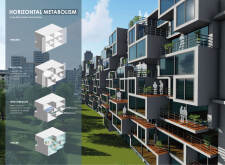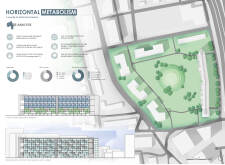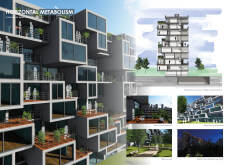5 key facts about this project
In this architectural project, flexibility is a fundamental principle. The design accommodates various family structures by offering modular duplex apartments intended for three to seven residents, with sizes ranging from seventy-five square meters to one hundred sixty-five square meters. This adaptability ensures that the units can meet the evolving needs of households, from single individuals to larger families, thereby promoting inclusivity within the community. Each living space is designed not only for comfort but also to facilitate interaction among residents, with private and communal terraces strategically interwoven throughout the layout. These terraces provide essential outdoor spaces that encourage social engagement and enhance the overall quality of life for residents.
A notable aspect of this project is its materiality. The choice of concrete as a primary structural element offers durability while allowing for varied architectural forms, creating an aesthetically pleasing environment. Additionally, extensive use of glass enhances natural light within the spaces, fostering a connection between indoor and outdoor settings. The incorporation of wood for balconies and terraces introduces warmth, inviting residents to spend time outdoors and solidifying the project’s commitment to creating a welcoming atmosphere. Steel elements, particularly in railing designs, ensure safety while maintaining a contemporary aesthetic that aligns with the overall vision.
The design thoughtfully integrates sustainable practices, emphasizing energy efficiency and ecological responsibility. This commitment is reflected in the orientation of the buildings, allowing for optimal sunlight exposure and the incorporation of green roofs and vertical gardens that contribute to improved air quality. By promoting such sustainable features, the project aligns itself with the principles of environmental stewardship, thus making a positive impact on urban living.
Furthermore, "Horizontal Metabolism" embodies a unique architectural approach that emphasizes the importance of community spaces in urban environments. By designing shared terraces and communal areas, the project encourages neighbors to connect and engage with one another, countering the isolating tendencies often found in urban living. This focus on community support reflects an understanding of the role that social interactions play in enhancing residents' quality of life.
In discussing the unique features of the design, it is vital to highlight the innovative configurations of living spaces that promote flexibility and comfort. The layout facilitates a harmonious balance between private and communal life, ensuring that residents can enjoy personal space while also having access to communal areas for socializing and recreation. This framework offers a modern interpretation of urban living that is responsive to contemporary societal needs.
The project's architectural ideas are underscored by its responsiveness to the socio-economic context of Robin Hood Gardens. By considering the demographics and diverse needs of the community, the design serves as a model for future developments in similar environments. It showcases how architecture can meaningfully contribute to social healing and community revitalization, offering valuable insights for urban planners and architects alike.
For those interested in delving deeper into the architectural design and intricacies of this project, exploring its architectural plans, sections, and various design elements would provide a fuller understanding of its intentions and aspirations. This analysis reveals a project that is not only well conceived in its structural elements but is also reflective of a broader vision aimed at enriching the lives of those within its walls and the community surrounding it. Engaging with the project presentation will undoubtedly offer valuable insights into the innovative architectural approaches embodied in "Horizontal Metabolism."


























